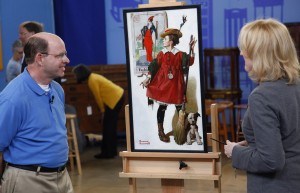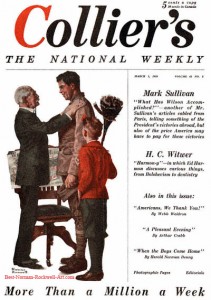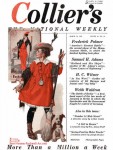 Antiques Roadshow was in Eugene, Oregon this weekend, where experts appraised an original oil painting by Normal Rockwell at half a million dollars, an estimate that ties for the second highest appraisal in the US Roadshow’s 15 year history.
Antiques Roadshow was in Eugene, Oregon this weekend, where experts appraised an original oil painting by Normal Rockwell at half a million dollars, an estimate that ties for the second highest appraisal in the US Roadshow’s 15 year history.
(The top estimate in AR history was $1,000,000 for a group of 18th century Qianlong carved jade and celadon pieces brought to Raleigh, North Carolina in 2009. They ended up selling at auction for under $500,000. The tie for second went to a 1937 Clyfford Still oil painting brought to the Roadshow in Palm Springs, California in 2008.)
John Jordan, the show’s publicist, said he could not reveal the identity of the painting’s owner but confirmed the person lives in the Springfield area.
The artwork is a 1919 original oil-on-canvas painting by Rockwell titled “The Little Model” that was used on a cover of Collier’s magazine. The painting depicts a girl with a dog, posing in front of a fashion poster. The owner told appraiser Nan Chisholm, of Nan Chisholm Fine Art in New York City, that the painting had been in the family for at least 90 years after Rockwell gave it to his great-grandmother.
The three Eugene episodes, including the one starring the Rockwell piece, won’t air until next year. PBS will announce the schedule this September.
Rockwell’s career as a commercial artist was still young in 1919. His first painting to grace the cover of a magazine was “Scout at Ship’s Wheel,” published in the Boy Scouts of America magazine Boys’ Life in September of 1913 when Rockwell was just 19 years old. He was the art editor for Boys’ Life at the time and made several more covers for the publication during his three-year tenure in the position.
When he was 21, his roommate, cartoonist Clyde Forsythe, introduced him to The Saturday Evening Post editor George Horace Lorimer. Lorimer liked what he saw and immediately purchased two of Rockwell’s cover paintings and commissioned three more. His first cover illustration for the Post, “Mother’s Day Off,” was published in May of 1916. Seven more cover paintings followed in quick succession within the next 12 months. Rival publications quickly lined up to score a Rockwell cover of their own, including Collier’s Weekly which had less than half the Post‘s readership.
 Rockwell published four covers for Collier’s in 1919. The first was “War Hero Job Hunting,” published on the March 1, 1919 issue. Despite his popularity, Rockwell had a difficult time getting this piece published and only turned to Collier’s once the larger circulation magazines had turned it down. Lorimer’s Post was a conservative magazine, whereas Collier’s Weekly had made a name for itself in the early 1900s for publishing muckracking series by Upton Sinclair on the Chicago meatpacking industry and by Samuel Hopkins Adams on patent medicines, among other topics. The Collier’s stories caused a furor and were instrumental in the passage of the Pure Food and Drug Act in 1906.
Rockwell published four covers for Collier’s in 1919. The first was “War Hero Job Hunting,” published on the March 1, 1919 issue. Despite his popularity, Rockwell had a difficult time getting this piece published and only turned to Collier’s once the larger circulation magazines had turned it down. Lorimer’s Post was a conservative magazine, whereas Collier’s Weekly had made a name for itself in the early 1900s for publishing muckracking series by Upton Sinclair on the Chicago meatpacking industry and by Samuel Hopkins Adams on patent medicines, among other topics. The Collier’s stories caused a furor and were instrumental in the passage of the Pure Food and Drug Act in 1906.
Norman Rockwell’s first Collier’s cover illustration depicts a uniformed World War I veteran being welcomed home by his father and little brother. I’m not sure why it was controversial enough to get rejected by the bigger magazines. The war wasn’t officially over yet — the Versailles Treaty would officially end the war on June 28, 1919 — but armistice had been declared on November 11, 1918, so troops were already coming home and looking for civilian work. Maybe they thought the title implied something malicious, like the war hero is a slacker, or that it described a social problem of veteran unemployment?
 “The Little Model” was his second Collier’s cover, published on March 29, 1919. Again, I don’t know why the Post didn’t want that one. Maybe because the young girl with her shredded wrap, torn seams and holes in her stocking holding a broom suggests a harsh reality of child labor/poverty that contrasts with the elegant Erté-style model she’s imitating? That’s more of a Collier’s topic, certainly, but it’s such a sanitized, innocuous depiction I can’t quite grasp why even Lorimer would object to it.
“The Little Model” was his second Collier’s cover, published on March 29, 1919. Again, I don’t know why the Post didn’t want that one. Maybe because the young girl with her shredded wrap, torn seams and holes in her stocking holding a broom suggests a harsh reality of child labor/poverty that contrasts with the elegant Erté-style model she’s imitating? That’s more of a Collier’s topic, certainly, but it’s such a sanitized, innocuous depiction I can’t quite grasp why even Lorimer would object to it.
The link to the article on the sale of the Chinese piece said, “But of course, the Roadshow is about the business of television, not about the business of selling antiques.” The AR “find” of this painting is the same thing, since the owner already knew what he had. Let’s hope that the AR doesn’t continue to morph into a spectacle of “what’s it worth” rather than “what is it” in the first place.
I can’t remember which show, but a family had a NR hanging in their living room for decades…a gift from Rockwell to their (deceased) father, also an artist. They lent it to a museum, where the experts were all “This is a forgery”. Wha??
Turns out their dad had painted the replica for display and built a hidden vault in the wall to house and protect the original 🙂
Mr. Murphy, many people use AR as an appraisal service. It’s not easy to find qualified art appraisers outside of major metro areas, and even then they aren’t affordable for regular families.
I get emails all the time from people asking me where they can take items to be appraised. There really are very few resources out there for regular folk not in major urban centers who’d like to know what they have.
That horse may be out of the barn already, to be honest. What keeps AR from descending into pure commercialism, I think, is the genuine passion the appraisers evince for their fields and how many of the people bringing objects in to be appraised consider themselves stewards of tradition, not just someone who got lucky at a garage sale and can now turn a big buck.
I like watching AR. It’s informative and entertaining. The motives and interests of the participants seem quite genuine. However, learning about the value is the endgame. The biggest winners (and ocassionally the biggest loosers) are ones featured with all of the commentary. Every piece even in the collateral “museum” spotlights gets a price. That’s TV.
By the way, if you live in the boonies and you want to learn about the price–look on ebay and other auction sites. The Internet has much to offer, and sometimes it’s more entertaining than a TV show.